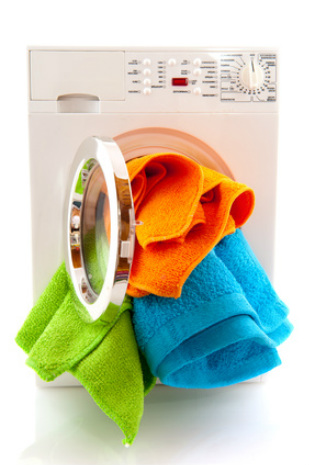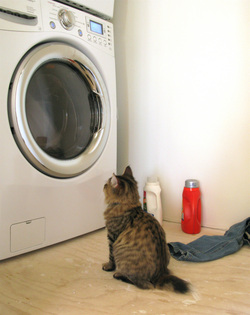
Dryer Repair
Having a dryer is much more convenient then an old clothing line. However when they break it can get very annoying and you might need to have your dryer repaired. Most of the driers consist of a motor, which contains pulleys and belts, which ultimately help to turn the dryer drum. The air is heated and circulated, drying your laundry in the process. Prior to having a professional dryer repair person come out and check out your broken appliance you can:
- First, check if it is plugged in.
- Then, check the switch and the door. If the door is not closed all the way it will not work.
- If it works but the air is not hot, you may have a problem with the heating element, thermostat sensors, or coils which should be replaced.
- If it won't start at all check for a blown thermal fuse. This particular fuse usually is attached to the exhaust duct inside of the back cover panel. You may need to replace it.
- If the motor works but the dryer does not turn, the dryer belt, which turns the drum, may be broken.
- If you decide to do the dryer repair on your own, always make sure that the dryer is unplugged when performing any type of dryer repair.
When all else fails, and you need to have someone repair your dryer, submit your request on the Contact Us page and we will have someone contact you promptly to assist you with your problem.
Dryer Maintenance
Whether you have a gas or electric dryer, there are a number of things that you can do to keep it running longer, better, safer and cheaper. Protecting your appliances with regular maintenance makes good sense. A major appliance is an expensive addition to your home, and proper maintenance can extend its life. Making more efficient use of your dryer saves you energy dollars too. Keep your dryer exhaust vent clear. Signs of a clogged dryer vent are clothes that take a long time to dry, or dryers that aren’t heating as quickly as they used to. Clogs happen fast, so check often. Clogged dryer vents make dryers run longer, shortening their useful life. The following maintenance will help make your dryer stay efficient:
- Separate items by weight. Lighter items and many synthetics need less time to dry. By separating items, you can maximize efficiency of your dryer while cutting down on unnecessary wear on the dryer.
- Avoid overloading your dryer. Running a huge drying load makes the dryer work harder and less efficiently.
- Clean the lint filter on your dryer after each use. This will maintain good air flow, which helps dry clothes faster.
- Clean your dryer's exhaust duct annually. Keeping the dryer's exhaust duct free of lint will reduce the number of clogs. It will also keep you safer. Clogged dryer ducts are a fire hazard, so keep them clear.
- Use your dryer efficiently. If you have a number of loads to do, don't fold a load by pulling items out of the dryer one at a time. Instead, pull an entire load out and reload with wet clothes while the dryer is still hot. Fold the freshly dried clothes while the new load is drying. This will keep the dryer from cooling down between loads and having to come back up to temperature. Changing your routine slightly will extend the life of the dryer and save on energy.
- Use only the drying power you need. Don't set the dryer for 70 minutes when 50 minutes will do the job. Do some creative observation to see how long it really takes to dry your clothes. Once you have a good idea, choose a more precise dryer setting for each load.
- Consider using a clothesline instead of your dryer. When drying large items like bedspreads, comforters and area rugs, use a clothesline for the bulk of the drying. When the items are almost dry, use the dryer to fluff and soften them for a few minutes before folding.

_How Dryers Work
Dryers are common tools used in every household. There are many types of dryers available like hair dryer, hand dryer, clothes dryer, cereal dryer, grain dryer, etc. Their utilities are different and so they are popular with a wide range of people. Dryers have motors, heating elements, thermostats, and switches. They also have a fan, a timer, and if they are quite expensive they may also have a sensor that responds to moisture in the clothes and turns off the machine when no more moisture is sensed. And they may have an ultraviolet light that has a bleaching effect on the drying clothes. One must have adequate knowledge of the mechanisms of the dryer to know when to get a dryer repair done.
How an Electric Dryer Works
The dryer works by tumbling the clothing and blowing air through the drum. The drum has baffles protruding into the drum to keep the clothes from bunching up. The length of time the dryer runs and the air temperature are elements of the various drying cycles.A motor turns the clothes drum and also turns a fan (called the blower). The air flow from the blower passes over a heating element (in an electric dryer) or through a gas jet (in a gas dryer). The air then passes through the drum and out the back of the dryer through ducts to the vent which is typically located outdoors.
The dryer cannot operate until the door switch signals that the door is closed. The start button must then be pressed to enable the timer control. The timer control either regulates the length of time the dryer runs or it works in conjunction with a moisture sensor that measures the water vapor in the drum to determine when the clothes have dried. The temperature selector controls the maximum temperature inside the drum with the aid of thermostats. The heat turns on and off as needed to maintain the temperature.
When the timed cycle ends, or the moisture sensor determines the clothes are dry, the drying cycle ends and typically a buzzer sounds to signal that the cycle has ended. Some dryers have a wrinkle prevention feature that will tumble the dryer every few minutes to prevent wrinkles from setting in.
How a Gas Dryer Works
The dryer works by tumbling the clothing and blowing air through the drum. The drum has baffles protruding into the drum to keep the clothes from bunching up. The length of time the dryer runs and the air temperature are elements of the various drying cycles. A motor turns the clothes drum and also turns a fan (called the blower). The air flow from the blower passes over a heating element (in an electric dryer) or through a gas jet (in a gas dryer). The air then passes through the drum and out the back of the dryer through ducts to the vent which is typically located outdoors.
A gas dryer uses a burner assembly which is comprised of a control valve with 1 or 2 solenoids (also called coils), a gas jet, an igniter and a sensor. When the dryer is started, the igniter heats up, when the sensor detects the heat, it signals the solenoid on the control valve to open and release the gas which is then lit by the glowing hot igniter. The igniter turns off but the gas jet remains open. The burning jet of gas keeps the sensor warm which keeps the gas valve open, until the thermostat signals the control valve to stop the flow of gas.
The dryer cannot operate until the door switch signals that the door is closed. The start button must then be pressed to enable the timer control. The timer control either regulates the length of time the dryer runs or it works in conjunction with a moisture sensor that measures the water vapor in the drum to determine when the clothes have dried. The temperature selector controls the maximum temperature inside the drum with the aid of thermostats. The heat turns on and off as needed to maintain the temperature.
When the timed cycle ends, or the moisture sensor determines the clothes are dry, the drying cycle ends and typically a buzzer sounds to signal that the cycle has ended. Some dryers have a wrinkle prevention feature that will tumble the dryer every few minutes to prevent wrinkles from setting in.
Dryers are common tools used in every household. There are many types of dryers available like hair dryer, hand dryer, clothes dryer, cereal dryer, grain dryer, etc. Their utilities are different and so they are popular with a wide range of people. Dryers have motors, heating elements, thermostats, and switches. They also have a fan, a timer, and if they are quite expensive they may also have a sensor that responds to moisture in the clothes and turns off the machine when no more moisture is sensed. And they may have an ultraviolet light that has a bleaching effect on the drying clothes. One must have adequate knowledge of the mechanisms of the dryer to know when to get a dryer repair done.
How an Electric Dryer Works
The dryer works by tumbling the clothing and blowing air through the drum. The drum has baffles protruding into the drum to keep the clothes from bunching up. The length of time the dryer runs and the air temperature are elements of the various drying cycles.A motor turns the clothes drum and also turns a fan (called the blower). The air flow from the blower passes over a heating element (in an electric dryer) or through a gas jet (in a gas dryer). The air then passes through the drum and out the back of the dryer through ducts to the vent which is typically located outdoors.
The dryer cannot operate until the door switch signals that the door is closed. The start button must then be pressed to enable the timer control. The timer control either regulates the length of time the dryer runs or it works in conjunction with a moisture sensor that measures the water vapor in the drum to determine when the clothes have dried. The temperature selector controls the maximum temperature inside the drum with the aid of thermostats. The heat turns on and off as needed to maintain the temperature.
When the timed cycle ends, or the moisture sensor determines the clothes are dry, the drying cycle ends and typically a buzzer sounds to signal that the cycle has ended. Some dryers have a wrinkle prevention feature that will tumble the dryer every few minutes to prevent wrinkles from setting in.
How a Gas Dryer Works
The dryer works by tumbling the clothing and blowing air through the drum. The drum has baffles protruding into the drum to keep the clothes from bunching up. The length of time the dryer runs and the air temperature are elements of the various drying cycles. A motor turns the clothes drum and also turns a fan (called the blower). The air flow from the blower passes over a heating element (in an electric dryer) or through a gas jet (in a gas dryer). The air then passes through the drum and out the back of the dryer through ducts to the vent which is typically located outdoors.
A gas dryer uses a burner assembly which is comprised of a control valve with 1 or 2 solenoids (also called coils), a gas jet, an igniter and a sensor. When the dryer is started, the igniter heats up, when the sensor detects the heat, it signals the solenoid on the control valve to open and release the gas which is then lit by the glowing hot igniter. The igniter turns off but the gas jet remains open. The burning jet of gas keeps the sensor warm which keeps the gas valve open, until the thermostat signals the control valve to stop the flow of gas.
The dryer cannot operate until the door switch signals that the door is closed. The start button must then be pressed to enable the timer control. The timer control either regulates the length of time the dryer runs or it works in conjunction with a moisture sensor that measures the water vapor in the drum to determine when the clothes have dried. The temperature selector controls the maximum temperature inside the drum with the aid of thermostats. The heat turns on and off as needed to maintain the temperature.
When the timed cycle ends, or the moisture sensor determines the clothes are dry, the drying cycle ends and typically a buzzer sounds to signal that the cycle has ended. Some dryers have a wrinkle prevention feature that will tumble the dryer every few minutes to prevent wrinkles from setting in.
Home - Contact Us - LG Appliances - Samsung Appliances - Model Number? - Washers - Dryers - Refrigerators - Stoves & Ovens - Dishwashers - Tips
_


